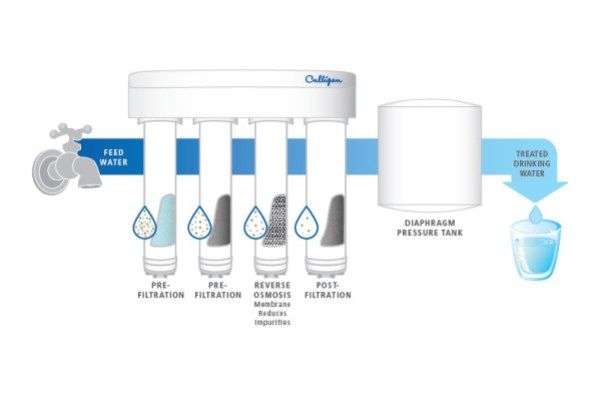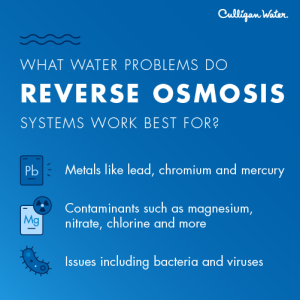What Water Problems Does Reverse Osmosis Remove?
Sometimes it takes advanced problem-solving to turn poor-quality water into cleaner, safer drinking water.
That’s where reverse osmosis (RO) filtration systems come in.
Effective at removing contaminants, solid substances, molecules, minerals and other impurities, RO systems are installed at the point of use to address water problems that many other systems cannot handle.*

RO filtration is an effective solution for broad treating your water against an expansive variety of possible contaminants, from bacteria to certain chemicals and other potential issues. These systems are most often installed under the sink in your kitchen (or sometimes, in the basement) to ensure that you have unlimited access to great-tasting drinking water. With a reverse osmosis filtration system ensuring that you have cleaner water for cooking and beverages, you can minimize your exposure to issues like these:
- Metals: Lead contamination can be relatively common, especially in areas where the infrastructure and water pipes are old and in need of repair
- Minerals: Calcium and magnesium are the two most common minerals that cause hard water
- Microorganisms: Bacteria and parasites, such as cryptosporidium, are common contaminants found in water sourced from lakes and rivers
Does Reverse Osmosis Remove Chlorine and Fluoride?
 Chlorine and fluoride are two chemicals that many people are interested in removing from their home drinking water. Through either the RO process or associated filtration stages found in many reverse osmosis systems, you can address concerns related to both substances.
Chlorine and fluoride are two chemicals that many people are interested in removing from their home drinking water. Through either the RO process or associated filtration stages found in many reverse osmosis systems, you can address concerns related to both substances.
While small amounts of fluoride likely don’t pose any problems – and may even be beneficial for fighting tooth decay – pervasive exposure to excessive amounts of the substance can cause issues for teeth and bones. In these instances, reverse osmosis can be an effective way to minimize the presence of fluoride in your drinking water.
Chlorine is commonly used by water treatment facilities as a disinfectant. Excessive concentrations of this chemical can cause illness, and some people may notice their drinking water tastes a bit like bleach. Many RO systems include a filtration stage that uses activated carbon to help reduce the amount of chlorine found in your drinking water.
What Is Not Removed by Reverse Osmosis?
RO can help you address a significant number of potential issues in your water, including possible contaminants and aesthetic concerns like taste and smell. However, the reverse osmosis process alone isn’t sufficient for handling some problems. Thankfully, sophisticated RO systems allow you to combine the capabilities of reverse osmosis with additional filtration stages, creating a more comprehensive solution for cleaner, great-tasting drinking water.
Beyond the RO phase, additional filtration support may be required for minimizing the presence of substances like:
- Emerging contaminants, including “forever chemicals” PFOS and PFOA
- Volatile organic compounds (VOCs)
- Viruses and bacteria
By working with professionals to assess your home water test results, you can develop a thorough plan for water treatment. For example, to solve some of the problems noted above, you might consider using Culligan’s Total Defense cartridge, which is compatible with RO solutions like the Aquasential® RO or Aqua-Cleer® systems. (We’ll highlight additional information about this option later in the article.)
Is It Bad To Drink Reverse Osmosis Water?
For households that have harmful contaminants in their water supply, like lead or certain microorganisms against which RO systems are effective, drinking reverse osmosis water is a safer option. With a comprehensive RO solution that is tailored to the results of your home water test through the inclusion of supplemental filtration cartridges, you can enjoy effective treatment for a wide variety of potential concerns.
Certain households may also be interested in remineralizing their water after it’s treated. For some people, this process improves the flavor. Options like Culligan’s Mineral Boost Cartridge can help you achieve the desired mineral content and taste for your household’s preference.
Which RO System Is Right for Me?
There are several different reverse osmosis systems on the market today, and with the support of an experienced professional, you can find the right option for your water treatment needs. Some popular solutions that you might consider during your search include:
Aquasential® Smart Reverse Drinking Water Filtration System: The most efficient reverse osmosis system on the market, the Aquasential Smart RO is certified to reduce 58 contaminants and offers up to 7 stages of filtration and 12 filter options. Smart technology lets you track water consumption and contaminants reduced. You can also see cost savings and bottles saved from reduced use of single-use plastic water bottles.
Aquasential® Reverse Osmosis Drinking Water System: Get an unlimited supply of cleaner, safer water with a system that’s customized to your home’s specific water needs. Also certified to reduce 60 contaminants, the system is designed for easy setup and maintenance. An optional integrated monitor light on your faucet can indicate when it’s time to change filters, which can last up to two years.
Aquasential® Tankless Reverse Osmosis System: The unique tankless design delivers the quality water your home depends on without taking up extra space under your sink. The filtration system reduces dissolved solids in your water by up to 95% and provides over 600 gallons of cleaner, safer drinking water per day.
Ready for Better Water in Your Home?
Schedule an appointment now for your free in-home water test or to receive a phone consultation. Your local Culligan water expert will help you make sure you’re receiving cleaner, safer water for your family.
*Contaminants may not necessarily be present in your water.